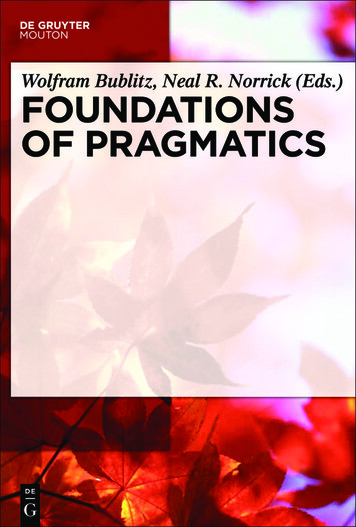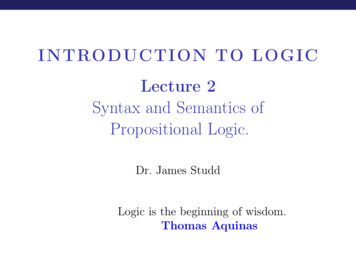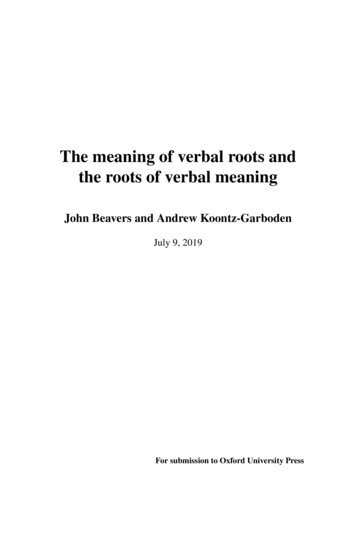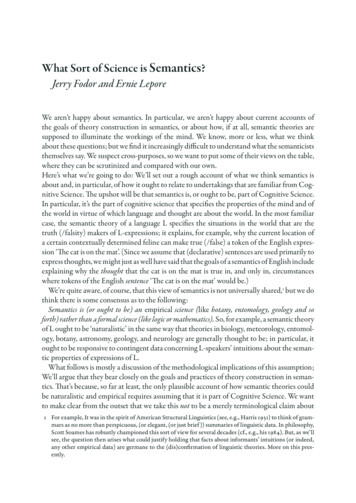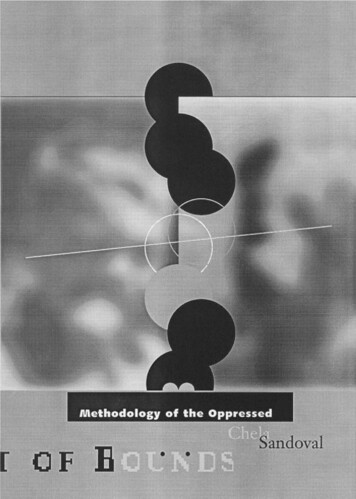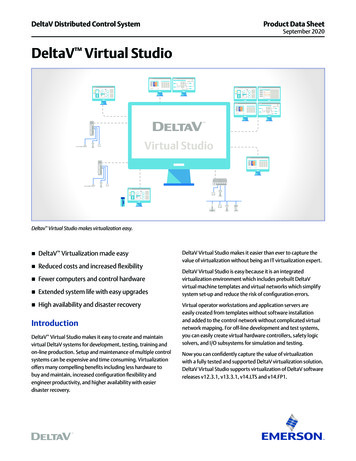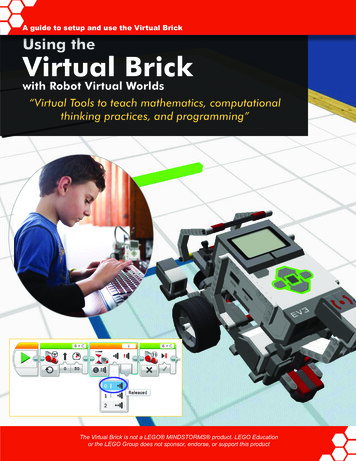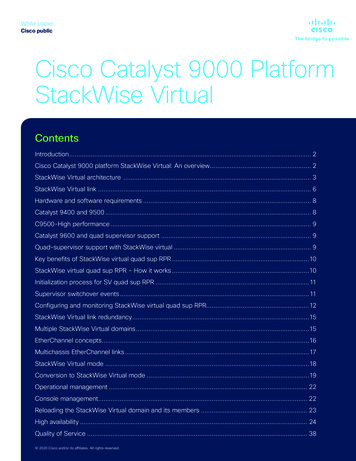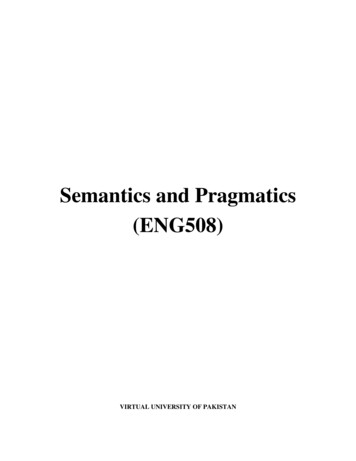
Transcription
Semantics and Pragmatics(ENG508)VIRTUAL UNIVERSITY OF PAKISTAN
Semantics and Pragmatics (ENG508)VUTable of ContentsLesson No.Lesson No. 1Lesson No. 2Lesson No. 3Lesson No. 4Lesson No. 5Lesson No. 6Lesson TitleINTRODUCTION TO SEMANTICS AND PRAGMATICSDefinition of Semantics and PragmaticsThe Borderline between Semantics and PragmaticsSentence and UtteranceLanguage and LogicThe Explicit and the ImplicitSEMANTICS AND LINGUISTICSSemantics in LinguisticsSemantics in a Model of GrammarHistorical SemanticsSemantics in Other DisciplinesSemantics and SemioticsIMPORTANT ASSUMPTIONS ABOUT SEMANTICSReference and SenseUtterance, Sentence and PropositionUtterance, Sentence and Proposition -ActivitiesLiteral and Non-Literal MeaningSemantics and PragmaticsTHEORIES OF MEANINGWhat Is meaning?Meaning Holism -Meaning within LanguageIdea Theory of MeaningMeanings Are out in the WorldMeaning of Sentences and Truth ConditionPutting Meaning Together from Pieces – Compositional TheoryKINDS OF MEANINGLinguistic/Conceptual MeaningConnotative/Referential MeaningSocial MeaningAffective MeaningReflective and Collocative MeaningThematic MeaningMEANING, THOUGHT AND REALITYSense and ConceptsNecessary and Sufficient ConditionsPrototypesLinguistic RelativityThe Language of Thought Hypothesis Copyright Virtual University of 22223232
Semantics and Pragmatics (ENG508)Lesson No. 7Lesson No. 8Lesson No. 9Lesson No. 10Lesson No. 11Lesson No. 12Lesson No. 13LEXICAL RELATIONS – IWhat are Lexical Relations?Words and Lexical ItemsProblems with Pinning Down Word MeaningHomonym and PolysemySynonyms and AntonymsLEXICAL RELATIONS – IIHyponymMeronymyCausative Verbs and Agentive NounsColour TermsCore Vocabulary and Universal LexemesLEXICAL SEMANTICS: FIELDS AND COLLOCATIONIntroductionPragmatic and Syntagmatic Relations – IPragmatic and Syntagmatic Relations – IISemantic FieldsCollocationsIdiomsSENTENCE RELATIONS AND TRUTHLogic and TruthPropositional LogicPredicate LogicEntailmentTruth Conditional SemanticsPRESUPPOSITIONIntroductionTwo Approaches to PresuppositionPresupposition FailurePresupposition TriggersPresupposition and ContextSENTENCE SEMANTICS – I: SITUATIONSIntroduction: Classifying SituationsTense and AspectModalityMoodEvidentialitySENTENCE SEMANTICS – II: PARTICIPANTSIntroduction: Classifying ParticipantsThematic Roles – I (Agent, Patient, Theme, Experiencer)Thematic Roles – II (Beneficiary, Instrument, Location, Goal,Source, Stimulus)Identifying Thematic Roles Copyright Virtual University of 3
Semantics and Pragmatics (ENG508)Lesson No. 14Lesson No. 15Lesson No. 16Lesson No. 17Lesson No. 18Lesson No. 19Lesson No. 20Problems with Thematic RolesSEMANTICS AND GRAMMARFormal GrammarGrammatical CategoriesGrammar and LexiconGrammatical RelationsCase GrammarFORMAL SEMANTICS TODAYDiversity within Formal SemanticsRelationship with other Varieties of SemanticsRelationship with other FieldsSemantics and Society - ISemantics and Society - IISEMANTICS AND DICTIONARYPractical DictionaryTheoretical DictionaryLexical Rules (Graded Accessibility)Types of Lexical RulesOther Observations about Lexical RulesINTRODUCTION TO PRAGMATICSWhat is Pragmatics?Types of PragmaticsWhat Does Pragmatics Study?Pragmatics and LinguisticsThe Emergence of Pragmatics as a Distinct FieldHISTORY OF PRAGMATICDevelopment and Expansion of PragmaticsPragmatics and Ordinary LanguageThe Term ‗Pragmatics‘The Prehistory of PragmaticsModern PragmaticsCONTEXT AND PRAGMATICSIntroduction to Context and PragmaticsSituational ContextBackground Knowledge ContextCo-textual ContextExploring ContextLANGUAGE IN CONTEXT: REFERENCEIntroduction to ReferenceReferring to the Context Outside: ExophoraReferring to the Context Inside: CohesionGrammatical CohesionLexical Cohesion Copyright Virtual University of 515152524
Semantics and Pragmatics (ENG508)Lesson No. 21Lesson No. 22Lesson No. 23Lesson No. 24Lesson No. 25Lesson No. 26Lesson No. 27COOPERATIVE PRINCIPLEIntroductionObserving the MaximsFlouting the MaximsViolating the MaximsLimitations of the Cooperative PrincipleRELEVANCE THEORYWhat Is Relevance Theory?Principles of Relevance TheoryExplicatures and ImplicaturesConceptual and Procedural MeaningAccessibility and Limitations of Relevance TheoryIMPLICATURE – IWhat Is Implicature?Conversational ImplicatureGeneralized Conversational ImplicatureScalar ImplicatureParticularized Conversational ImplicatureIMPLICATURE – IIProperties of Conversational ImplicatureConventional ImplicatureProperties of Conventional ImplicatureStrong ImplicatureWeak ImplicatureDEIXIS- IWhat is Deixis?Spatial DeixisPerson DeixisSocial DeixisTemporal DeixisDEIXIS- IIDiscourse DeixisDeictic ReferenceDeictic CenterThe Limits of IndexicalityRaising Pragmatic AwarenessPRESUPPOSITION AND ENTAILMENT IN PRAGMATICSIntroductionTypes of PresuppositionThe Projection ProblemOrdered EntailmentsPresupposition in the Real World Copyright Virtual University of 3656565666613413513613768686869138695
Semantics and Pragmatics (ENG508)Lesson No. 28Lesson No. 29Lesson No. 30Lesson No. 31Lesson No. 32Lesson No. 33Lesson No. 34VUSPEECH ACTS THEORYIntroduction to Speech ActsAustin‘s Speech Act Theory1391407171Searle‘s Speech Act Theory14171Felicity Conditions14272Direct and Indirect Speech 8686SPEECH ACTS AND SOCIETYSocial DimensionsCultural DimensionsLimitations of Speech Act TheoryMacro-functionsExploring Speech ActsPOLITENESS THEORYWhat Is Politeness Theory?Face WantsNegative and Positive FaceSay Something: Off and On RecordPositive and Negative PolitenessPoliteness StrategiesPOLITENESS AND CONTEXTForm and FunctionSituational ContextSocial ContextCultural ContextApplying PolitenessCONVERSATIONAL ANALYSISWhat Is Conversational Analysis?Turn-TakingPauses, Overlaps and BackchannelsAdjacency PairsPreference StructureSequencesCULTURE AND LANGUAGE LEARNINGCross-cultural PragmaticsIntercultural PragmaticsInter-language PragmaticsListener Behavior in CCPReferential CommunicationCOMPUTER SEMANTICS AND PRAGMATICSComputers and LinguisticsComputers, Corpora and Semantics Copyright Virtual University of Pakistan6
Semantics and Pragmatics (ENG508)Lesson No. 35Lesson No. 36Lesson No. 37Lesson No. 38Lesson No. 39Lesson No. 40Computers and the Study of TranslationComputers and PragmaticsComputers, Speech Acts and ConversationINFORMATION STRUCTURE AND PRAGMATICSIntroduction to Information StructureGiven and New InformationTopics and ContrastDefinite and Referential ExpressionsGeneric and Specific ExpressionsRESEARCH IN PRAGMATICSThe Nature of Pragmatic InvestigationCollecting Data for Pragmatic AnalysisTranscription of ConversationInvestigable TopicsLearning by DoingKEY TERMS IN PRAGMATICS-IAmbiguity, Disambiguation and VaguenessAttributive Concept and Argumentation Theory / Referential /Attributive DistinctionCode ModelCommunicative CompetenceDemonstrativeEllipsisKEY TERMS IN PRAGMATICS-IIFolk PragmaticsFormal and Experimental PragmaticsCognitive PragmaticsFragmentMetaphor and SynecdocheHyperbole and IronyKEY TERMS IN PRAGMATICS-IIII-Principle and M-PrincipleQ-Principle and R-PrincipleLinguistic Under - Determinacy ThesisManifestness and MarkednessMisfireProsody and TautologyKEY THINKERS IN PRAGMATICSJohn Langshaw AustinNoam Avram ChomskyHerbert Paul GriceStephen C. LevinsonJohn Rogers Searle Copyright Virtual University of 57
Semantics and Pragmatics (ENG508)Lesson No. 41Lesson No. 42Lesson No. 43INTERACTIONAL CONSTRUCTION OF IDENTITYIntroductionRole of Sociocultural Factors in IdentityAction TheoryStudies of IdentitiesOccasioning Identity WorkIdentity Work in an Educational ContextLANGUAGE, GENDER, AND POWEREnactment of Gender in Language UseLanguage and Gender: Western and Non-Western perspectivesPower: Language and GenderWorking of Language and Power: Political DiscourseGender and Power InteractionsCLASSROOM PRAGMATIC DEVELOPMENTIntroductionWhy Is Pragmatic Competence Important for 2nd LanguageLearners?Can Pragmatic Competence be Taught or Learnt in InstructedContext?What Gets in the Way of Developing Pragmatic Competence in aClassroom?What can be Done to Facilitate Teaching and Learning ofPragmatic Competence?Training in Pragmatics Outside the Traditional LanguageClassroom? Copyright Virtual University of 2241132251148
Semantics and Pragmatics (ENG508)VULesson 01INTRODUCTION TO SEMANTICS AND PRAGMATICSTopic-001: Definition of Semantics and Pragmatics Learning TheoriesSemantics is the part of linguistics that is concerned with the study of literal, de-contextualizedand grammatical meaning (Frawley, 1992). Linguistic semantics is the study of how languages organizeand express meanings (Kreidler, 1998). The language uses a system of linguistic signs, each of which is acombination of meaning and phonological and/or orthographic forms. In the semantic analysis, there isalways an attempt to focus on what the words conventionally mean, rather than on what an individualspeaker might want hearer to mean on a particular occasion. Therefore, we can say, it is the study of therelationships between signs and symbols and what they represent.Pragmatics is the study of meaning as communicated by the speaker and interpreted by thelistener‖. According to Yule (2010), ‗Pragmatics is the study of ―invisible‖ meaning, or how werecognize what is meant even when it isn‘t actually said or written‘. This includes background knowledgecontext i.e. people know about each other and the world. Pragmatics may vary from culture to culture.The relationship between the linguistic form and communicative function is of central interest in―Pragmatics‖.Topic – 002 The Borderline between Semantics and PragmaticsBoth semantics and pragmatics involve studying meaning, but they are generally seen asdifferent fields. Semantics is the study of the contribution made to meaning by the meanings of linguisticitems and the way they are combined. Lexical semantics deals with word meaning, and compositionalsemantics deals with the way the meanings of lexical items combine to give phrase and sentence meaning.On this view of semantics, pragmatics takes up where semantics leaves off. Whereas, pragmatics isconcerned with what is conveyed by a particular utterance of a phrase, by a speaker, in a context.The borderline can be seen as falling at the division between encoded and inferred aspects ofmeaning, between truth-conditional and non-truth-conditional aspects of meaning, or between sentencemeaning and speaker meaning.Topic – 003 Sentences and UtterancesAccording to Chapman (2011), Semantics is concerned with sentences and Pragmatics isconcerned with utterances. Sentences are linguistic entities and there are semantic facts about anylanguage concerning the meanings of its words and the ways in which they can combine together to givemeaning. However, an utterance is an instance of the production of a sentence or a fragment of asentence. The most obvious distinction between the sentence and utterance is that utterance will havespatio-temporal and physical properties while, the sentence does not. Sentences are abstract linguisticstructures; they do not have contexts and they are not produced by speakers or received by hearers. Copyright Virtual University of Pakistan9
Semantics and Pragmatics (ENG508)VUTopic – 004 Language and LogicLogic is concerned with ways in which ideas relate to each other, can be combined together andcan be used to derive other ideas with confidence. Logicians tend not to talk about ‗ideas‘ though; thebasic unit of traditional logic is the ‗proposition‘; a significant term in the discussions of meanings inlinguistics.Propositions are the meanings that are expressed by declarative sentences; can be the contents ofthoughts. The logical meaning of simple propositions is determined by the principle of compositionality.Compositionality holds that the meaning of a whole is made up by combining together, by ‗adding‘, themeaning of its parts. Thus, the meaning of a proposition is composed of the meaning of subject plusmeaning of the predicate.Topic – 005 The Explicit and the ImplicitPragmatists are interested in cases where what the speaker intends to convey is different from thewords one chooses literally mean. The former is generally known as the implicit meaning and the latter asthe explicit meaning. The fact that both implicit and explicit meanings are so different, suggests that thereare some ‗pragmatic principles‘ that are shared by the speakers and the hearers towards intendedinterpretations. Pragmatists are interested to determine the nature and extent of these principles and toanswer a question why speakers rely so much on implicit meaning.In nearly all cases, where there is a difference between implicit and explicit meaning, the implicitmeaning conveys a lot more than what is literally expressed; and literal meaning underdetermines themeaning conveyed. Copyright Virtual University of Pakistan10
Semantics and Pragmatics (ENG508)VULesson 02SEMANTICS AND LINGUISTICSTopic – 006 Semantics in LinguisticsSemantics is a technical term used to refer to the study of meanings. The meaning covers avariety of aspects of the language but unfortunately, there is no general consideration to describe it(Palmer, 1997). Modern linguistics includes various meditations regarding the knowledge of linguistics,i.e. how to pronounce the words, construct sentences and meanings (Saeed, 2004). Since the linguisticdescription is an attempt to show a speaker‘s knowledge, semantics is ascribed to elaborate semanticknowledge.Semantics has an association with the other fields of studies i.e. philosophy and psychology, asthey also investigate the creation and transmission of the meanings (Saeed, 2004). One thing to keep inmind is that an individual‘s meaning is not a part of the general study of semantics.Topic – 007 Semantics in a Model of GrammarAccording to Palmer (1997), almost all the linguists, overtly or covertly, admit that in a linguisticmodel, semantics is on one end and phonetics on the other, while grammar is at somewhere in the middle.Many other linguists argue that the aim of doing semantics is to set up a component of the grammarwhich is parallel to the other ones, e.g. syntax or phonology.According to Saeed (2004), phrases and sentences also have the meanings, of course, but animportant difference between word meaning on one hand, and the phrase and sentence meanings on theother, concerns productivity. There is always a possibility to create new words, but relatively it is notmuch frequent to occur.Chomsky, in particular, has commented on the creativity of the sentence formation. It is one ofthe generative grammar‘s most important insights that relatively a small number of combination rulesallow the speakers to use a finite set of words to create a very large and infinite number of sentences. Toallow this, the rules for sentence formation must be recursive, allowing the repetitive embedding orcoordination of syntactic categories (Saeed, 2004).Topic – 008 Historical SemanticsAccording to Palmer (1997), the term ‗semantics was first used to refer to the development andchange of meaning'. There are different reasons for semantic changes. Generalization of meaning, forexample, ‗arrive‘ originates in Latin ‗arripare‘ - ‗movement that ends at the banks of a river‘.Specialization of meaning, for example, ‗girl‘ originally referred to ‗children in general‘ and was laterrestricted to ‗female children‘ only (Krifka). Some changes are merely fortuitous – e.g. ‗money‘ is relatedto Latin ‗moneo‘ (warn) because money was made in the temple of the goddess Juno Moneta (Rome).Some changes arise from new needs – e.g. ‗car‘ was an obsolete word for ‗chariot‘, until the motor-car Copyright Virtual University of Pakistan11
Semantics and Pragmatics (ENG508)VUwas invented.One powerful source for meaning change is taboo (Palmer, 1997).A word that is used for something unpleasant is replaced by another time and again.For example, English has had the terms privy, lavatory, toilet, bathroom, loo, etc. Historical linguistics orComparative Philology attempts both to reconstruct the history of Languages and to relate languagesapparently coming from a common source (Palmer, 1997).The study of the origin and uses of particular words is called etymology. It includes observationsabout previous meanings of a word or its precursors. Etymological dictionaries attempt to quote at leastthe most recent origin of each word. Synchronic study must precede the diachronic study of languagebecause we cannot study the change in a language until we have first established what the language waslike at the time during which it changed (Palmer, 1997).Topic – 009 Semantics in other DisciplinesSemantics has not been the only concern of linguists; philosophers, anthropologists, andpsychologists have also shown their interest in this subject. Some philosophers have suggested that manyphilosophical problems may be solved by the study of ordinary language.E.g. the problems of the nature of ‗good‘ and ‗evil‘, of right and wrong, in moral philosophy. Traditionallogic is also concerned with semantics as some of its proposals range from simple syllogism to highlycomplex logical syntax. Logic makes use of concepts found in ordinary language (‗and‘, ‗or‘, etc.).Anthropologists are also concerned with language as an essential part of the cultural andbehavioural patterns of the people - a linguist should not ignore this. The importance of these patterns hasbeen established by Malinowski in his proposals concerning the CONTEXT OF SITUATION (Palmer,1997, p. 14). The relation between Psychology and Linguistics has given rise to Psycholinguistics.It is also focused that how we process language both in its production and reception. It is largelythrough the influence of certain psychologists that behaviourist analyses of meaning have been proposed.One example is to be found in the work of Charles Morris, his book, Sign, Language and Behaviorpublished in 1946. He is more concerned with the signs and what they denote or signify.Topic – 10 Semantics and SemioticsLinguistic meaning is a special subset of the more general human ability to use signs to conveymeanings, e.g. traffic lights are the combination of colours to instruct the drivers and even to warn them.It is believed that human language differs in kind more than a degree from other languages (Palmer,1997).Scholars (e.g. Ferdinand de Saussure, 1974) are of the view that linguistics is a part of the generalstudy of the use of the sign system, which is called Semiotics. Semioticians have probed the relationshipthat may be between the sign and the object it represents or in Saussure‘s terminology, between signifierand its signified (Saeed, 2004). Copyright Virtual University of Pakistan12
Semantics and Pragmatics (ENG508)VUThere are some important terminologies: Signifier: Any material thing that signifies, e.g., words on a page, a facial expression, an image. Signified: The concept that a signifier refers to Together, the signifier and the signified make up a meaning. Sign: The smallest unit of meaning. Anything that can be used to communicateTypes of signs are given below: Distinction, highlighted by C. S. Peirce, between Icon, Index and Symbol. Iconic signs: Signs where the signifier resembles the signified. Similarity between a sign and what it represents. e.g., between a picture and its real-life subject. Indexical Signs: Signs where the signifier is caused by the signified. Copyright Virtual University of Pakistan13
Semantics and Pragmatics (ENG508)VULesson 03IMPORTANT ASSUMPTIONS ABOUT SEMANTICSTopic – 11 Reference and SenseThese terms were introduced by Friedrich Ludwig Gottlob Frege (1848 -1925) in his treatiseentitled ―Über Sinn und Bedeutung‖ from 1892, translated into English as ―On sense and reference‖.―Reference has to do with the relationship which holds between an expression and what thatexpression stands for on particular occasions of its utterance‖ (Lyons, 1977). According to Saeed (2004),Reference is ―relationship by which language looks onto the world is usually called reference‖. Thus,reference can be concluded as the meanings of a word in any language which exist in the real world.Allan describes that ―Sense is a decontextualized meaning, abstracted from innumerableoccurrences in texts‖. Sense relates to the complex system of relationships between the linguisticelements themselves (mostly the words). Concerned only with intra-linguistic relations‖ (Palmer, 1981).According to Saeed (2009), the ―semantic links between elements within the vocabulary system is anaspect of their sense‖. It can be concluded that ―sense‖ exists in the word and this is a word to wordrelation.Topic – 12 Utterance, Sentence and PropositionAccording to Haung (2014), proposition is a declarative sentence, when uttered to make astatement, that is, to say something true or false, about some state of affairs in the external world. Theword proposition has come from philosophy and is the lowest level of language. Propositions arewords that exist in the lexicon and have a meaning.A sentence is a group of abstract grammatical elements obtained from utterances. A well-formedstring of words put together by the grammatical rules of language (Huang, 2014). The sentence is somehigher level of language, it may have many propositions. When a proposition is combined withgrammar, it becomes a sentence. We can say that a sentence is a complete expression while propositionis partial.According to Leach (1981), ―Utterance is a natural unit of speech bounded in articulation‖.According to Huang (2014), it is a particular piece of language that can be a word, a phrase, a sentence,or a sequence of sentences- spoken or written by a particular speaker or writer in a particular context ona particular situation. It is the most concrete level of language. Utterance is always written in invertedcommas to indicate that what is put between them is taken from a specific context on a specific occasionof use. For instance, ―I am reading the novel.‖, ―Hello!‖, ―A Cappuccino, please.‖ Copyright Virtual University of Pakistan14
Semantics and Pragmatics (ENG508)VUTopic – 13 Activities on Utterance, Sentence and PropositionUtterance: Practice - Decide whether the following could represent utterances. Indicate your answer bycircling Yes or No.(1) ‗Hello‘(2) ‗Not much‘Yes / NoYes / No(3) Utterances may consist of a single word, a single phrase or a single sentence. Yes / No(4) They may also consist of a sequence of sentences. Yes / No(5) It is also not unusual to find utterances that consist of one or more grammatically incompletesentence-fragments. Yes / No(6) No simple relation of correspondence between utterances and sentences. Yes / NoSentence: Practice -Practice – Following are some sample conversations. In each case, the secondutterance is not a token of a sentence. Write out a full sentence expressing the intended meaning.(1) Magnus: ‗When did Goethe die?‘Fred: ‗In 1832‘.(2) Hostess: ‗Would you like tea or coffee?‘Guest: ‗Coffee, please‘.(3) A: ‗Who won the battle of Waterloo?‘B: ‗Wellington‘ .Proposition: Practice – Take a news story from a newspaper and underline the propositions.Topic – 14 Literal and Non-Literal MeaningAccording to Saeed (2003), Literal Meanings - told by a dictionary of that language are calledconventional meanings. These meanings are a description of the word to which it refers to in the realworld. These are Instances where the speaker speaks in a neutral, factually accurate way. E.g. ―I amhungry or I am starving.‖ The source of these meanings is a society which gives meaning to the words.These meanings are also called conceptual meaning.Non-Literal Meanings are Instances where the speaker deliberately describes something inuntrue or impossible terms in order to achieve special effects. For instance, ―I could eat a horse‖ or ―my Copyright Virtual University of Pakistan15
Semantics and Pragmatics (ENG508)VUstomach is screaming for food‖. Non-Literal Meanings are also traditionally called figurative and aredescribed by a host of rhetorical terms including metaphor, irony, metonymy, etc.‖ (Saeed, 2003, p.17).These are associated meaning of the words - symbolic meaning.Topic – 15 Semantics and PragmaticsThere are three different schools of thoughts on the distinction between semantics andpragmatics. One group of linguists says that only three fields of linguistics are pure linguistics i.e.semantics, morphology, and syntax. They do not include pragmatics in pure linguistics as it does not relyon logic and ignore it by saying that anyone can interpret language according to his own desire. Thisschool of thought is known as semanticism.While other group, of linguists holds that semantics is only a study of conceptual meaning butreal conversation takes place within pragmatics. Without pragmatics, everything is useless becausewithout it meaning will be partial and incomplete. This school of thought is called pragmatism.While the third and most recent school of thought is of the view that both semantics andpragmatics are important. According to them, Pragmatics gives non-literal meaning and semantics givesliteral meanings. By concluding this, we can say that Semantics is concerned with sentence meaning meaning in language and Pragmatics is concerned with the speaker‘s meaning - meaning in socialcontext. Copyright Virtual University of Pakistan16
Semantics and Pragmatics (ENG508)VULesson 04THEORIES OF MEANINGTopic – 16 What Is Meaning?Semantics deals with the study of meaning. The verb ‗mean‘ has multiple meanings/ senses indictionary. Have a look at the following sentences: ‗I mean to be there tomorrow‘.‗What I mean to do‘. (Intention)‗That cloud means thunder‘‗A red light means ‗Stop‘‘. (Sign both natural and conventional)The most relevant use of the term for our purpose may be found in the following sentence:‗What does calligraphy mean?Words, phrases or ideas which are given to understand a certain idea – same meaningFinding sameness may be a problem (Palmer, 1997, p. 3)Meaning is connected to language via the lexicon and grammar and also to what we do with thelanguage. Sense relations are synonymy, antonymy, hyponymy, etc. The meaning of an expression is afunction of the meaning of its parts and the way they are put together. Sometimes, we need to seemeaning within the framework of an academic or scientific discipline; called compositional meanings.Topic – 17 Meaning Holism – Meaning within LanguageA word is defined in terms of some of the very words which help us to define. This view issimilar to ‗meaning holism‘ (Quine, 1960) – the meaning of a word/phrase/ sentence depends on itsrelationship with other words, e.g. part of what makes up the meaning of ‗tall‘ is that it is opposed to themeaning of ‗short‘. Holist theory tends to be functional in the sense that it is some aspect of the uses of apiece of language which makes for its meaning. If you call something ‗tall‘, you should be willing to callit ‗not short‘.The critics of this theory also argue that the way language express thought is not as arbitrary asthe holist‘s view predicts. There may be deep, consistent and sophisticated patterns in how languagesexpress meaning. Meaning holism may be correct in a way, it does not provide a basis for the scientificstudy of linguistic meaning. That is why; it has not been appreciated by formal semanticists (Portner,2005, p. 3-5)Topic – 18 Idea Theory of MeaningIf meanings are not words, our next guess might be that meanings are something in the mind:concepts, thoughts or ideas. This theory explains the patterns in how languages express meaning in termsof the nature of concepts – ultimately, the way the brain is structured. Copyright Virtual University of Pakistan17
Semantics and Pragmatics (ENG508)VUThere are some challenges faced by the Idea Theory to come up with a sound psychologicaltheory of what concepts or ideas are. Secondly, it needs to provide a concept for every meaningful pieceof language (Portner, 2005, p. 5)If idea theory is to work, ideas will have to have a language-like nature – grammar. Ideas act as alanguage of thought. According to Portner (2005), concepts are formed by the experiences of people –experiences may vary from person to person. These arguments weaken idea theory.Topic – 19 Meanings Are out in the WorldThere are certain philosophical views/theories which lead us to think that ‗meanings are out inthe world‘. Some theorists believe that meanings are social practices. When somebody says something,it should be thought as a kind of move in a giant language game we play. This game has rules whichimply that if somebody asks: ‗What time is it?‘ The reasonable move for you is to say ‗It is X o‘clock‘.This t
Semantics and Pragmatics (ENG508) - Virtual University . The - - .
